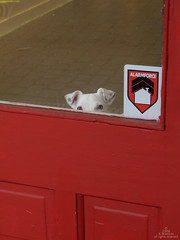<blurt>
I've been trying to consolidate my thoughts about "Designing the Next Generation of Web Apps" panel that i'm due to partake in next Tuesday. One thing i've thought a lot about in designing Flickr is how to locate someone in the big mess that is user-generated content.
I think i've realised that there probably isn't any sort of easy way to do introduce people to The Mess That Is TM given that people are simply interested in what they're interested in and will seek that out naturally. (So, by the way, phooey! all you let's-commercialise-the-attention-economy people.)
Imagine for a moment if your brief as a designer is:
You don't know what the result will be.
Let's say someone comes cold to one of these new-fangled Web 6.7 places. We don't know who they are, where they are from, what they like, what their income is, or what language they speak. Can we assume that they probably want to:
Take that into the hardware world for a moment... you give a person a piece of hardware. You have no idea if they will:
A main difference between the "old" and "new" generations of web apps is that consumers may now become producers. Push returns to pull. Basically, design an airport (sexy of course): people come, need to know where to go, pass through authentication (or not), then leave, possibly with some data trailing behind them. Leave the rules of engagement as open as possible. Lack of rules means people can decide what they're comfortable with, and that means play. That's good. (See Amy Franceschini's excellent Board Game sculpture.)
As an aside, social patterns and reference that we all use offline are starting to become more realistic expectations online. (First impressions, second impressions, being made "real" by who you know etc. Let's face it - you used to be able to be a dog. Oh, the photos.)
I wonder if that means we need to come back to creating a enviroment where the key goal is simply to realise the environment (and not its contents). Enough with the Brand-Driven, Marketing-Speak, Jargon-Fest, Replete-With-Buzzwords-And-VPs. And actually, your everywoman/everyman doesn't give a flying **** about the beauty of database connectivity, microformats or mashups. They may like mashed vegetables, but that's about it.
Build it, and they might stay, or they might just pop in, or they might just build amazing things with your data.
</blurt>
I've been trying to consolidate my thoughts about "Designing the Next Generation of Web Apps" panel that i'm due to partake in next Tuesday. One thing i've thought a lot about in designing Flickr is how to locate someone in the big mess that is user-generated content.
I think i've realised that there probably isn't any sort of easy way to do introduce people to The Mess That Is TM given that people are simply interested in what they're interested in and will seek that out naturally. (So, by the way, phooey! all you let's-commercialise-the-attention-economy people.)
Imagine for a moment if your brief as a designer is:
You don't know what the result will be.
Let's say someone comes cold to one of these new-fangled Web 6.7 places. We don't know who they are, where they are from, what they like, what their income is, or what language they speak. Can we assume that they probably want to:
- get started quickly,
- know if it will suit them,
- see that it's not too hard to use, and
- realise they may find some resonance in some people or content? (That's where flickr is so lucky, with photos.)
- a way to identify themselves,
- a familiar word,
- a friendly face,
- an actual friend (Gold!),
- a group of people,
- some weird stuff that other people have done that you might like...
Take that into the hardware world for a moment... you give a person a piece of hardware. You have no idea if they will:
- love it
- smash it
- sell it
- create a conference about it
- detest every fibre of its existence
- use it to 1/100th of its potential
- adapt it, or
- ...
A main difference between the "old" and "new" generations of web apps is that consumers may now become producers. Push returns to pull. Basically, design an airport (sexy of course): people come, need to know where to go, pass through authentication (or not), then leave, possibly with some data trailing behind them. Leave the rules of engagement as open as possible. Lack of rules means people can decide what they're comfortable with, and that means play. That's good. (See Amy Franceschini's excellent Board Game sculpture.)
As an aside, social patterns and reference that we all use offline are starting to become more realistic expectations online. (First impressions, second impressions, being made "real" by who you know etc. Let's face it - you used to be able to be a dog. Oh, the photos.)
I wonder if that means we need to come back to creating a enviroment where the key goal is simply to realise the environment (and not its contents). Enough with the Brand-Driven, Marketing-Speak, Jargon-Fest, Replete-With-Buzzwords-And-VPs. And actually, your everywoman/everyman doesn't give a flying **** about the beauty of database connectivity, microformats or mashups. They may like mashed vegetables, but that's about it.
Build it, and they might stay, or they might just pop in, or they might just build amazing things with your data.
</blurt>
